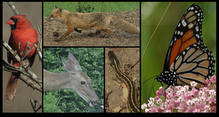 While walking along the Water Walk in San Antonio, I came across this great egret who was walking back and forth on a bridge foundation clearly looking for a meal. He walked around for about 5 minutes, then gave up and flew down the Water Way.
While walking along the Water Walk in San Antonio, I came across this great egret who was walking back and forth on a bridge foundation clearly looking for a meal. He walked around for about 5 minutes, then gave up and flew down the Water Way.
 A large white heron, the Great Egret is found across much of the world, from southern Canada southward to Argentina, and in Europe, Africa, Asia, and Australia. It's the largest egret in the Old World, and thus has garnered the name Great White Egret. But in the Americas, the white form of the Great Blue Heron is larger and warrants that name. In the United States, the Great Egret used to be called the American Egret but that was hardly appropriate, since the species range extends beyond America and indeed farther than other herons.
A large white heron, the Great Egret is found across much of the world, from southern Canada southward to Argentina, and in Europe, Africa, Asia, and Australia. It's the largest egret in the Old World, and thus has garnered the name Great White Egret. But in the Americas, the white form of the Great Blue Heron is larger and warrants that name. In the United States, the Great Egret used to be called the American Egret but that was hardly appropriate, since the species range extends beyond America and indeed farther than other herons.
 Plume hunters in the late 1800s and early 1900s reduced North American populations by more than 95 percent. The populations recovered after the birds were protected by law. No population is considered threatened, but the species is vulnerable to the loss of wetlands.
Plume hunters in the late 1800s and early 1900s reduced North American populations by more than 95 percent. The populations recovered after the birds were protected by law. No population is considered threatened, but the species is vulnerable to the loss of wetlands.
 >The Great Egret is the symbol of the National Audubon Society, one of the oldest environmental organizations in North America. Audubon was founded to protect birds from being killed for their feathers.
>The Great Egret is the symbol of the National Audubon Society, one of the oldest environmental organizations in North America. Audubon was founded to protect birds from being killed for their feathers.
 >Not all young that hatch survive the nestling period. Aggression among nestlings is common and large chicks frequently kill their smaller siblings.
>Not all young that hatch survive the nestling period. Aggression among nestlings is common and large chicks frequently kill their smaller siblings.
 >Not all young that hatch survive the nestling period. Aggression among nestlings is common and large chicks frequently kill their smaller siblings.
>Not all young that hatch survive the nestling period. Aggression among nestlings is common and large chicks frequently kill their smaller siblings.
 >The longevity record for a wild Great Egret is nearly 23 years.
>The longevity record for a wild Great Egret is nearly 23 years.
















No comments:
Post a Comment